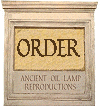
|
Reproduction Ancient Oil Lamps
Judea
The replica ancient oil
lamps in this section represent clay lamp styles used in ancient Judea
or the Holy Lands. They span from the time of the Old Testament to the
coming of the Christian movement in ancient Israel. Several of
these clay lamps are
molded directly from ancient oil lamps. Others are made using ancient
motifs on lamp bodies made from a mold of an undecorated
original lamp. These reproduction Judean lamps can be
used with olive oil like the originals.
Sales will resume in 2025.

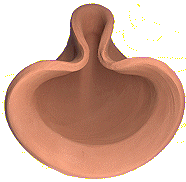 |
CANAAN
Circa 1500 BC to 600 BC
Among the earliest
of clay lamps is the saucer
lamp. While styles changed from the Bronze Age to the Iron Age, and
saucer lamps were used in some areas into Medieval times, this variety
is closest to the Late Bronze/Early Iron age transition. In antiquity,
these developed after a shallow
bowl had its edges folded to form a spout. These lamps would have been
the style in use in the Old
Testament.
Every Canaan lamp is hand folded, so minor variation from that
seen
in the photo will occur, but all have this general look.
(about 4.75 inches in
diameter)
|

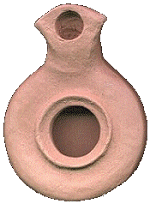
|
HERODIAN
Circa 50 BC to AD
70
This is the
best choice for a lamp type common in Judea during the
ministry
of Jesus.
Known as the Herodian
because of its widespread
use
during the
reign of Herod the Great (circa 37 BC to 4 BC), these lamps were
typically wheel made with the spout applied by hand. Although
mainly
confined to the Jerusalem area, they
have also
been
found at Herodian, Masada, and other Jewish settlements in the
region. This lamp, which is smaller than the
one below, is
made in a Roman style mold. Molded directly from an
original.
|

 |
DAROM
Circa AD 70 to AD
135
Following the Roman
destruction of the Second Temple, a
new
lamp style
was developed in the
Hebron hill region
by refugees from Jerusalem. Now mold-made, it
was clearly descended from the Herodian. The style was popular from
about
AD 70 to the end of the Bar-Kokhba Revolt in AD 135. The grape and lily
motif is molded from a cast of an original lamp. Darom was a
major production
area of this style. The grapes may imitate a golden grape cluster at
the
Temple in Jerusalem.
(3.75" by 2.75")
|

 |
HEBRON
Circa AD 70 to AD
135
A Darom style lamp, this
model
features
a stylized palm tree with clusters of dates and vines, possibly a
reference
to the First Fruits festival in Israel. The symbol is also used in love
poems (see Song of Solomon 7:8) and compared to the righteous (Psalms
92:12).
(3.75" by 2.75")
|

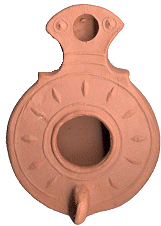 |
MARISA
Circa AD 70 to AD 135
<>
Yet another Darom type. The
discus has a radiating pattern around the central filling hole. On
either side of the wick hole are two raised circular designs.
(3.75" x 2.75") |

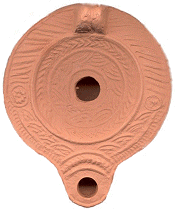 |
VERONA
Circa 2nd-3rd century
AD
This lamp, molded
directly from the original, has an interesting "modern" history. It was
acquired by a prominent San Francisco philanthropist in the early
1900s, supposedly in Egypt, and put on display during a special World
Exposition. It was afterwards donated to a museum. It was subsequently
heavily damaged in the earthquake of 1908, and several years later what
remained of it was deaccessioned. The discus is a detailed geometric
pattern. While the original was
reportedly acquired in Egypt, this was probably a lamp made in ancient
Israel.
|

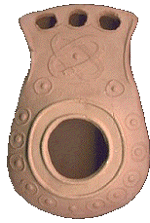 |
ASKELON
Circa 2nd Century AD
A three-wick lamp,
styled after original examples from Israel. Multi-wicked lamps produced
more light, but also required more tending.
(4" by 2.5")
|

 |
SAMARIA
Circa AD 200 to AD
300
Modeled after an
original example
found
in Samaria,
Central Palestine. The Samaria features impressed leaves around a
large central filling hole and has a slightly impressed circular
ring on the base.
(2.75" by 2.5")
|

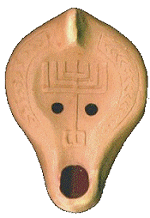 |
ATRIPALDA
Circa AD 300 to
400
The Atripalda lamp
features a depiction of the Seven-Branched Menorah which was in the
Temple of Jerusalem, captured by the Romans in the 1st Century AD. The
reproduction is
styled after
an original Roman North African lamp dating to the 4th century AD,
now
in a museum in Jerusalem. Another very similar lamp was excavated from
Atripalda, in Italy. Depictions of the Menorah are rare on early lamps,
but more
common in later centuries.
(3.5" x 2")
|

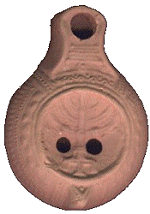 |
HAIFA
Circa AD 300 to AD
400
The Haifa also
features a Menorah. This lamp, however, is of
a style more closely associated with an origin in the Holy Lands. Lamps
similar to this model are known from
Samaria
as well. This lamp is made from a cast of an original from Jerusalem.
Similar lamps are in the Hebrew University
collection, as
well one in the Hect Museum at the University of Haifa.
(3.5" by 2.5")
|

 |
BETHANY
Circa AD 400 to
500
A Byzantine
"candlestick" lamp. Many researchers call the design a stylized
menorah, although some argue it could also be a stylized palm
branch, as many were used in Christian as well as
Jewish homes of the 5th and 6th centuries AD.
Molded directly from an
original.
(3.75" by 2.75")
|

 |
JERUSALEM
Circa AD 400 to
500 <>Another
of the
Byzantine lamp styles, this model features a cross near the wick hole.
This design was common in the Jerusalem area and the
original used for this was acquired in Jerusalem. Circa 5th-6th
Centuries AD.
Molded directly from an original.
(about 4" by 2.75")
|

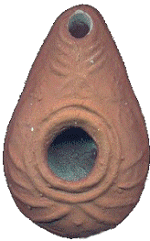 |
GOLGOTHA
Circa AD 300 to
500
Similar to the
Bethany, the Golgotha includes not only the palm branch or Menorah
symbol, but also two grape
bunches on the shoulder. The design is somewhat dulled as this was
molded
directly from a lamp purported to be an original from the Holy
Lands. I have since come to the conclusion the "original" lamp is a
fake.
(3.5" by 2")
|


The information
and graphics on this site are
copyright
|














